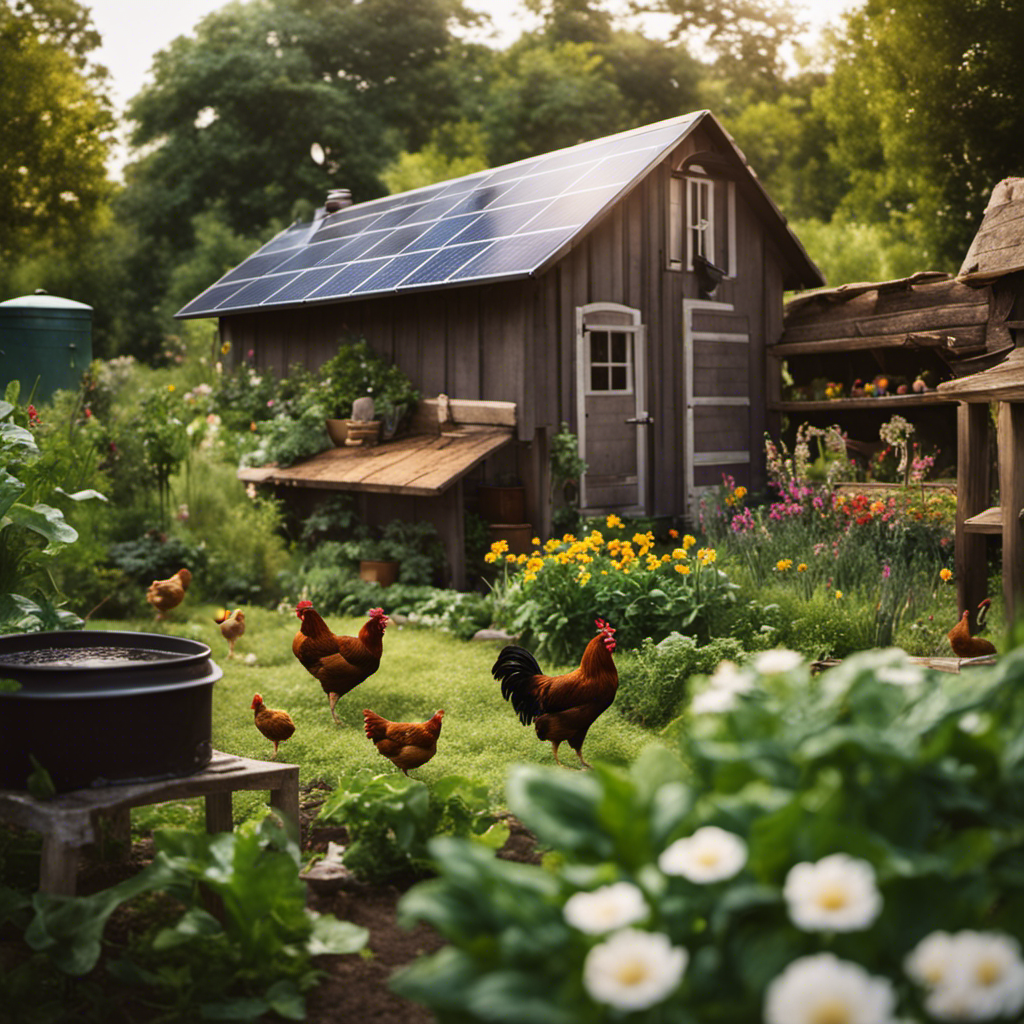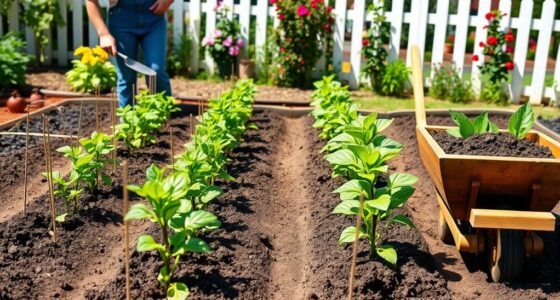A rainwater harvesting system that works effectively captures runoff from your roof using gutters and directs it into storage tanks or cisterns. It reduces your reliance on municipal water, cuts down water bills, and eases strain on city systems. Regular maintenance like cleaning filters and tanks keeps the water quality high. When well-designed and properly maintained, these systems seamlessly integrate into your home and urban infrastructure. Explore further to discover how to set up a reliable rainwater harvesting setup.
Key Takeaways
- Select durable, corrosion-resistant components like gutters, filters, and storage tanks suited for local climate conditions.
- Incorporate first-flush diverters to improve water quality by discarding initial runoff containing debris.
- Ensure proper system design for seamless integration with existing urban drainage and household water use.
- Regularly clean and maintain gutters, filters, and tanks to prevent contamination and ensure efficiency.
- Use reliable backup sources or additional filtration to maintain continuous water supply during dry periods.

Rainwater harvesting systems offer an efficient way to collect and utilize rainwater, reducing reliance on municipal water supplies and lowering your water bills. By implementing a rainwater harvesting system, you’re not just saving money—you’re also contributing to the broader effort of improving urban infrastructure and promoting water conservation. Urban areas often face challenges like limited water resources and aging infrastructure, making sustainable solutions more crucial than ever. Your decision to harvest rainwater can ease the strain on city systems, helping to preserve water for essential uses and reducing the risk of stormwater runoff overloads that can cause flooding or pollution.
A well-designed rainwater harvesting system begins with capturing rain from rooftops or other surfaces. Gutters and downspouts channel water into storage tanks or cisterns, where it’s kept clean and ready for use. Choosing the right storage capacity depends on your water needs and the amount of rainfall in your area. Smaller systems might suffice for garden watering or toilet flushing, while larger setups can support irrigation or even household use. The key is to integrate your system seamlessly into existing urban infrastructure, ensuring that your setup doesn’t cause drainage issues or clutter.
Water conservation is at the heart of effective rainwater harvesting. Using harvested rainwater reduces your dependence on municipal supplies, which are often strained during droughts or peak usage periods. It also minimizes the demand on treated water, which requires significant energy and resources to produce. When you incorporate rainwater into your daily routines, you’re actively participating in a more sustainable lifestyle that helps conserve essential water resources. Moreover, harvesting rainwater can decrease the volume of stormwater runoff, which often carries pollutants into rivers and lakes, disrupting ecosystems and water quality. Proper maintenance, including regular cleaning of gutters, filters, and storage tanks, is essential to prevent contamination and ensure water quality. Installing first-flush diverters can also help discard initial runoff that might carry debris or pollutants from rooftops, maintaining cleaner water. Connecting your system to garden irrigation, toilet flushing, or washing machines maximizes the utility of harvested rainwater and further reduces your reliance on municipal water. Additionally, reliable backup systems can ensure continuous water supply during dry periods or system failures, making your rainwater harvesting setup more resilient and effective.
Frequently Asked Questions
What Are the Initial Costs of Installing Rainwater Harvesting Systems?
The initial costs of installing rainwater harvesting systems typically range from $1,000 to $5,000, depending on size and complexity. You should do a cost estimation considering equipment, installation, and permits. Funding options like grants or loans can help reduce expenses. By exploring these, you’ll better understand your investment and make informed decisions to install a reliable system that suits your needs.
How Much Maintenance Is Required for These Systems?
You’ll find that rainwater harvesting systems require minimal maintenance to stay durable. Typically, you should check and clean filters and gutters every few months, especially after heavy storms. Regular inspections ensure system durability and prevent blockages or damage. Maintenance frequency is moderate, and staying proactive helps your system function efficiently year-round. With proper upkeep, your system remains reliable and effective over time, giving you peace of mind and sustainable water supply.
Are Rainwater Harvesting Systems Suitable for All Climates?
Rainwater harvesting systems are incredibly adaptable, but they’re not suitable for every climate. You might find they excel in regions with consistent rainfall, offering regional suitability for your needs. However, if you’re in an area with extreme droughts or heavy pollution, these systems could be less effective. So, while they can be a game-changer for many, always assess your local climate’s adaptability before installing one.
How Do I Ensure Water Quality and Safety?
To guarantee water quality and safety, you should use effective filtration techniques like screens, sediment filters, and UV sterilization to remove debris and pathogens. Regular water testing helps you monitor contamination levels and confirm safety. Keep your system clean by inspecting and maintaining filters frequently. Using these methods, you can enjoy safe, clean rainwater for your household needs, reducing health risks and ensuring water purity.
Can Rainwater Harvesting Systems Be Integrated With Existing Plumbing?
Where there’s a will, there’s a way. You can definitely integrate rainwater harvesting systems with your existing plumbing, but it depends on system compatibility and proper plumbing integration. You’ll need to make certain your system is compatible with your current setup, possibly requiring additional fittings or valves. Consulting a professional helps make sure the integration is seamless, safe, and efficient, allowing you to utilize rainwater without disrupting your home’s plumbing.
Conclusion
By mastering the art of rainwater harvesting, you can create a cost-effective, eco-friendly water source. Implementing simple systems saves space, sustains supplies, and supports sustainability. So, start small, stay strategic, and see your systems succeed. Remember, with consistent care and clever collection, you’ll cultivate a clean, constant, and cost-conscious water solution. Make your move today—maximize your moisture management and make every drop count!









